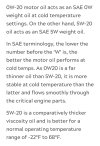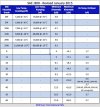The author of that mess is completely clueless. The SAE uses two tests to determine an oils winter rating, which is what the W stands for, not "weight". The first test is the cold cranking simulator, CCS, and it measures an oils ability to allow an engine to crank at cold temperatures. The CCS test methodology is outlined in ASTM D5293. To achieve a 0 winter rating the oil must pass the test at -35C, to achieve a 5 winter rating the oil must pass the CCS test at -30C.
The second test is the mini-rotary viscosity, MRV, and measures an oils ability to be pumped at cold temperature. The MRV test methodology is outlined in ASTM D4684. To achieve a 0 winter rating the oil must pass the MRV test at -40C, to achieve a 5 winter rating the oil has to pass the test at -35C.
Until the ambient temperature is in the -25F or so range there is no real difference in pumpability between 0W-xx and 5W-xx oils., and at that temperature both oils are extremely viscous, the 0W is a little less likely to gel at those extreme temperatures than 5W. Since vehicles use positive displacement oil pumps a 0W-xx oil isn't going to pump or "flow' faster than a 5w-xx, the oil pump will be sending the same volume of oil regardless of the oils winter rating.
The SAE defines operating temperature as 100C (212F) and at that temperature both oils are 20 grade, which means they have a kinematic viscosity range of 6.9-9.29 centistokes (CST). 0W-20 isn't inherently thinner than 5W-20 and 5W-20 isn't inherently thicker than 0W-20. Since 20 grade is a range of viscosities, as are all of the SAE recognized grades, one may be a bit thinner or thicker depending on what final viscosity the blender was aiming for.
Attached is SAE J300 which clearly displays all of the viscosity data.
View attachment 133461
www.repairsmith.com














